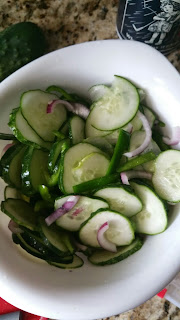Blueberries are one of my favorite fruits and have been for a long time. After putting in the fence, I had the perfect spot to add blueberry bushes along the back. Last year I put in two and after they did well I added two more this year. The blueberry bushes came from a nursery, so they were actually mature enough to produce fruit the first year. If you purchase the little blueberry plants they sell at the hardware store, it may take a few years for it produce berries. There are many different varieties and different bushes have different flavors. Some berries are smaller and sweeter, while some are larger and more tart. I have 3 Patriot and 1 Chippewa - and I can certainly tell a difference between the berries. You also want to make sure you are getting plants that flower at the same time so you get cross pollination. Some varieties bloom early while some are late. Just do your research about what kind of berries you want when shopping for the plants.
 |
| Four blueberry bushes and the net cage |
With blueberries, you have to fight the birds to get them ripe. To combat the birds, I built a net cage around the bushes and used rocks to hold the edges down. I threw a rubber snake on the ground for good measure. (The snake was an easy addition - found it at the local dollar store.) You have to wait until the blooms are gone and berries have formed before you put up the net, otherwise it discourages bees and insects from pollinating your bushes.
 |
| Blueberries starting to ripen! |
After putting up the netting, it was a waiting game. Thankfully, storms cleared out and the bushes got some hot, sunny days so that the berries ripened. To pick, I roll up the netting and pick the ripe berries. It is important to check them every couple of days, because if you don't get them as soon as they ripen the birds and bugs will swoop in. If you only get a few berries in one picking, you can rinse them and save them in the fridge, then add new berries in a couple days. In this way, I got a cup and half of berries, which is just what my muffin recipe called for!
 |
| A pretty good crop for one picking |
This is the blueberry muffin recipe I tried ~
To Die for Blueberry Muffins. The muffins turned out great - fluffy, lots of berries, and a fantastic cinnamon sugar crunch on top. I will definitely be saving this recipe to make again!
 |
| Blueberry muffins - from scratch with homegrown berries! |































